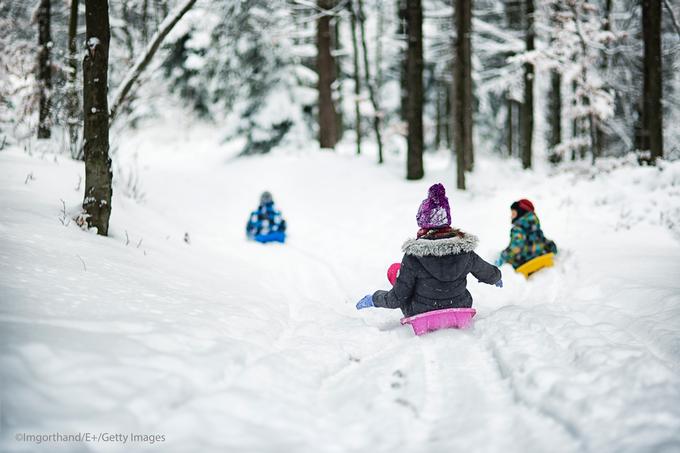
Published 12/13/2018
ROSEMONT, Ill. (December 13, 2018)– Skiing, snowboarding, ice skating and tobogganing are a few fun activities to help keep you active during the cold and snowy season. But, before you consider hitting the slopes, think about safety techniques to avoid common injuries, such as ankle or muscle strains and broken bones.
According to the Consumer Product Safety Commission (CPSC), in 2017, emergency departments, doctors’ offices and clinics treated:
“Overexerting yourself on the slopes can lead to injuries ending your run for the season,” said spokesperson for the American Academy of Orthopaedic Surgeons (AAOS) and orthopaedic foot, ankle and trauma surgeon Lori K. Reed, MD. “Individuals are at an increased risk of injuries such as sprains, strains, dislocations and fractures due to exhaustion. You can prevent these by staying in good physical condition year-round and listening to your body. Don’t push your body when you are in pain or too tired.”
The AAOS offers the following tips for winter sports safety:
According to the Consumer Product Safety Commission (CPSC), in 2017, emergency departments, doctors’ offices and clinics treated:
- 68,809 people for snow skiing-related injuries.
- 54,349 people for snowboard-related injuries; and
- 52,308 people for ice skating-related injuries; and
- 4,499 people for toboggan-related injuries.
“Overexerting yourself on the slopes can lead to injuries ending your run for the season,” said spokesperson for the American Academy of Orthopaedic Surgeons (AAOS) and orthopaedic foot, ankle and trauma surgeon Lori K. Reed, MD. “Individuals are at an increased risk of injuries such as sprains, strains, dislocations and fractures due to exhaustion. You can prevent these by staying in good physical condition year-round and listening to your body. Don’t push your body when you are in pain or too tired.”
The AAOS offers the following tips for winter sports safety:
- Keep in shape and condition muscles before participating in winter activities.
- Warm up thoroughly before playing or participating. Cold muscles, tendons, and ligaments are more vulnerable to injury.
- Take a lesson (or several) from a qualified instructor, especially in sports like skiing and snowboarding. Learning how to fall correctly and safely can reduce the risk of injury.
- Wear appropriate protective gear, including goggles, helmets, gloves and padding.
- Check that equipment is working properly prior to use.
- Wear several layers of light, loose and water-and wind-resistant clothing for warmth and protection. Layering allows you to accommodate your body’s constantly changing temperature. Wear proper footwear that provides warmth and dryness, as well as ample ankle support.
- Drink plenty of water before, during, and after activities.
- Know and abide by all rules of the sport in which you are participating.
- Avoid participating alone in a winter sport.
- Pay attention to warnings about upcoming storms and severe drops in temperature.
- Seek shelter and medical attention immediately if you, or anyone with you is experiencing hypothermia or frostbite. Make sure everyone is aware of proper procedures for getting help, if injuries occur.
For a guide to winter sports injury prevention visit, OrthoInfo.org.
More Information about the AAOS
With more than 38,000 members, the American Academy of Orthopaedic Surgeons is the world’s largest medical association of musculoskeletal specialists. The AAOS provides educational programs for orthopaedic surgeons and allied health professionals, champions and advances the highest quality musculoskeletal care for patients, and is the authoritative source of information on bone and joint conditions, treatments and related issues.
More Information about the AAOS
With more than 38,000 members, the American Academy of Orthopaedic Surgeons is the world’s largest medical association of musculoskeletal specialists. The AAOS provides educational programs for orthopaedic surgeons and allied health professionals, champions and advances the highest quality musculoskeletal care for patients, and is the authoritative source of information on bone and joint conditions, treatments and related issues.
# # #
Visit AAOS, at:
Newsroom.aaos.org for bone and joint health news, stats, facts, images and interview requests.
ANationinMotion.org for inspirational patient stories, and orthopaedic surgeon tips on maintaining bone and joint health, avoiding injuries, treating musculoskeletal conditions and navigating recovery.
Orthoinfo.org for patient information on hundreds of orthopaedic diseases and conditions.
Facebook.org/AAOS1
Twitter.com/AAOS1
Instagram.com/AAOS_1
Contact AAOS Media Relations